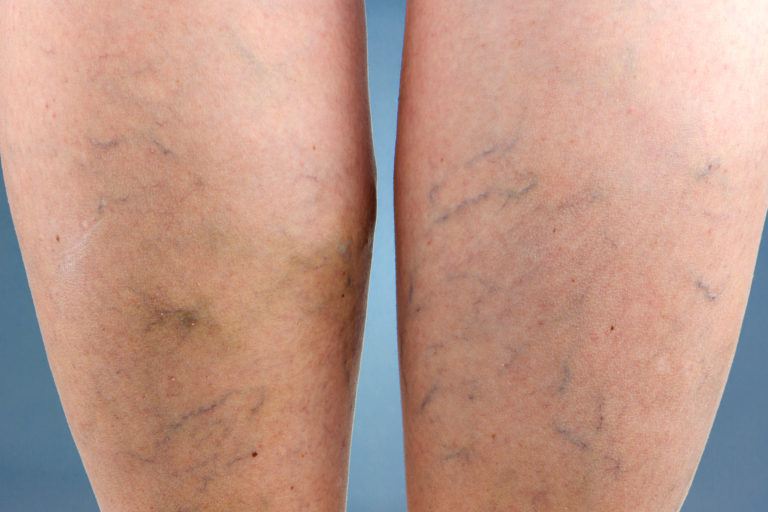
I don’t know about you, but when I hear “spider veins” I think of, well, spiders. And spider legs. Really, really long spider legs, creepy crawling their way up my legs. Yuck. Luckily for me, this topic actually has nothing to do with spiders, just spider veins, which are actually milder and smaller versions of varicose veins, which we all know about. We should be able to get rid of spider veins with some good ol’ knowledge.
Spider veins, and varicose (from the latin root varix, which means twisted) veins, are veins that have become swollen and twisted from weakened or blocked circulation. Spider and varicose veins can happen anywhere in the body, but usually occur in the lower legs and feet, because of the added pressure from sitting and standing upright all day. Varicose and spider veins typically appear dark red, blue, or purple in color; varicose veins can appear to bulging beneath the skin, while spider veins will look more like webbing across the surface of the skin. Symptoms of spider and varicose veins can vary from mild irritation to severe pain.
Spider and varicose veins are most common in women, especially older women, but everyone can be affected by vein abnormalities. Luckily for you, we have suggestions below for getting rid of your spider veins, and treating varicose veins and other vein abnormalities.
Symptoms of Spider Veins
- aching or heavy feelings in your legs
- burning, throbbing, or cramping in your lower legs
- itching around your veins
- in extreme cases, skin ulcers can form near your ankle
Best Treatments for Spider Veins
Promote healthy circulation in your legs to get rid of spider and varicose veins.
Regular exercise (even just a short walk), loose clothing and low-heeled shoes, changing positions frequently and sitting with your legs uncrossed your legs (long periods of stasis and crossed legs can aggravate circulation problems), and elevating your legs above your heart when resting can all go a long way to improving your circulation and reducing the appearance and presence of spider and varicose veins in your legs.
Maintain a healthy weight to prevent and get rid of spider and varicose veins.
Extra weight puts extra pressure on your legs, which makes healthy circulation harder for your body and can result in spider or varicose veins. Shedding those excess pounds with a healthy diet and exercise can reduce spider veins by relieving some of the pressure on your legs and increasing and improving circulation. Plus, you’ll be healthier in general. And that’s what we all really want anyway!
Sclerotherapy is a very common treatment for spider and varicose veins
in which a doctor injects small and medium affected veins with a solution that scars and closes the veins, forcing the body to redirect the circulating blood to healthy veins. After a few weeks the appearance of those affected veins should fade, and your discomfort relieved. Veins may need to be reinjected, but the outpatient procedure is fairly simple and relatively painless (no anesthesia is required).
Laser surgery is another common treatment for spider and varicose veins
that uses intense bursts of light to fade the affected vein. Traditionally, laser surgery was used mostly for smaller veins in the face and upper body, but newly developed technology has made the procedure viable for veins in the legs. Because laser surgery is non-invasive, fast, and does not require an incision or needle, it is a popular choice for getting rid of spider and varicose veins. Multiple treatments may be necessary to fully “vanish” the veins.
Other, more traditional methods of surgery are also available to get rid of spider and varicose veins.
These surgeries, including ambulatory phlebectomy, catheter-assisted procedures, endoscopic vein surgery, and vein stripping , are more invasive (they can require anesthesia), than sclerotherapy or laser surgery, but work effectively to remove or close the veins completely.
Best Spider Vein Remedies
Compression stockings
are a common first approach to treating spider and varicose veins. Compression stockings are support stockings clinically developed to improve circulation by squeezing your legs throughout the day. They’re widely available in varying strengths (even prescription) and styles (you’ve got to be stylish while you compress). Here’s a 6-pack from Dr. Motion at Amazon in a variety of those styles.
Getting a massage
is another effective way of increasing circulation to get rid of spider and varicose veins. Depending on how severe your symptoms are, you may want to get massages more or less frequently, with varying intensity.
Dietary and herbal supplements
claiming to relieve spider vein swelling and improve circulation are widely available. As with any alternative supplements, be careful about what you believe and what you buy. Vitamins C and E are viable options for reducing swelling, and a diet high in fiber and low in salt can reduce constipation and swelling, both of which contribute to spider and varicose veins. You can find both Vitamin E Supplements and Vitamin C supplements at Amazon.
Complications of Spider Veins
Gone untreated, spider and varicose veins can develop into more serious vein abnormalities and circulation problems. Other, serious, types of varicose veins include venous lakes, pooling blood in the veins of the face and neck; reticular veins, flat blue veins behind the knees; and telangiectases, reddish clusters of blood vessels on the face and upper body. Brown pigmentation can be a warning sign of skin ulcers, which can be the result of the increased pressure in the effected veins and needs immediate medical attention. Enlarged and swollen veins can cause your legs to swell also, and sudden leg swelling (with or without redness and irritation) can be indicative of a blood clot, a serious medical condition known as thrombophlebitis, which requires immedate attention.